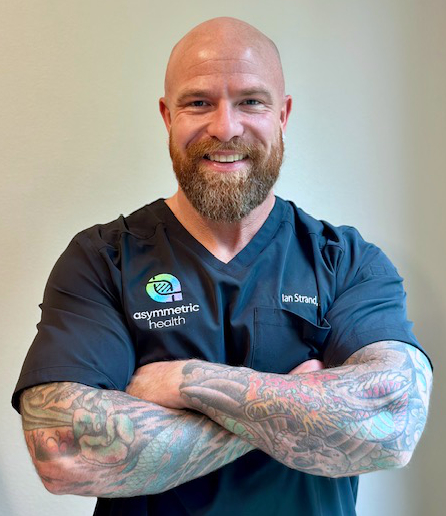Direct Primary Care (DPC): Fundamentals Guide
Welcome to a New Model of Healthcare
Asymmetric Health is a direct-pay primary medical practice specializing in a functional medicine approach to health-span optimization.
Our mission is to provide evidence-based, personalized, safe, and effective medical care to men and women seeking a proactive, health-focused approach to maximizing their health-span rather than waiting for the traditional diseases of aging.
While we offer several membership tiers tailored to individuals seeking hormone and cellular optimization, our core mission is rooted in the Direct Primary Care model — a model built around accessible, full-spectrum functional medicine for our community. We believe that every individual deserves proactive, personalized care that not only addresses symptoms but aims to optimize long-term health. Our DPC structure allows us to restore the patient-provider relationship and focus on prevention, longevity, and quality of life through comprehensive, evidence-based medicine.

What Is Direct Primary Care (DPC)?
Direct Primary Care is a healthcare model that eliminates the middleman (insurance) and fosters a direct relationship between you and your provider. Instead of paying for each appointment, test, or form individually, you pay a flat monthly membership fee that covers nearly all of your primary care needs.
Core Features of DPC:
- Unlimited visits with no copays
- Same- or next-day appointments
- Direct messaging with your provider
- Extended visit times
- In-office procedures and acute care
- Preventive screenings and chronic condition management
What DPC Is NOT
• Not Health Insurance: DPC is not a substitute for health insurance. It is recommended that you maintain a high-deductible plan or health-sharing membership for catastrophic events.
• Not for Specialty or Emergency Care: DPC covers most primary care needs but does not include hospitalization, imaging, or specialist visits.
• Not Transactional: You don’t pay per visit. You’re not rushed out the door. You’re paying for a relationship and access.
A Brief History of DPC
DPC emerged in the early 2000s as a response to rising patient dissatisfaction and physician burnout caused by a deeply flawed insurance-based healthcare system. Traditional fee-for-service models became increasingly dominated by health insurance companies, which created rigid reimbursement structures, interfered with clinical decision-making, and often dictated care based on billing codes rather than patient needs. Physicians found themselves increasingly sidelined in determining what was best for their patients, leading to mounting frustration and diminishing quality of care.
Administrative burdens exploded — prior authorizations, billing codes, documentation for reimbursement, and performance metrics tied to insurance contracts began to consume more of a physician’s time than patient care itself. This led to the widespread corporate acquisition of small, independent practices. Physicians were funneled into large healthcare systems focused on revenue generation, where visit times were shortened, patient panels ballooned, and autonomy was stripped away. In this shift, patients became customers, and doctors were reduced to cogs in a machine designed to extract revenue, not deliver care.
This corporate practice of medicine caused an epidemic of burnout. More physicians retired early, fewer medical students chose to enter primary care, and community-based resources dwindled. The result: even with health insurance, many patients today find they can’t get in to see a doctor, wait months for appointments, and get just 10–15 minutes of face-to-face time when they finally do.
DPC is a return to sanity — and humanity — in medicine. It removes the friction, restores the patient-provider relationship, and allows for care that is timely, thoughtful, and truly centered on your needs.

The Modern Patient Experience
The culmination of all these systemic issues has led to a frustrating and all-too-common experience for patients today: paying a high monthly premium for insurance that feels like it doesn’t actually cover care. Despite being insured, many individuals are unable to see their primary care doctor when they need to. Appointment slots are booked out for weeks or months, and last-minute cancellations are common. When urgent issues arise, patients are often told to go to the emergency department — not because it’s the best option, but because it’s the only one available. Even more frustrating is that once patients follow this advice and go to the ED, they are frequently faced with long waits, only to be told they do not have an emergent medical problem and should follow up with their primary care provider — the very same provider who was unavailable and referred them there in the first place! To add insult to injury, patients are then stuck with significant out-of-pocket costs for an emergency room visit they never wanted, all because the system left them with no other choice. The system is overloaded, impersonal, and reactive.
This reality contributes to the growing dissatisfaction with traditional healthcare and highlights why Direct Primary Care is such an important and refreshing alternative.
How DPC Can Save You Money
Combining Direct Primary Care (DPC) with a High-Deductible Health Plan (HDHP) and a Health Savings Account (HSA) can be a strategic way to lower your overall healthcare costs while still maintaining access to comprehensive care.

Here’s how it works:
• DPC: You pay a predictable monthly membership fee for unlimited access to your primary care team, without copays or billing hassles. Your membership includes extended visits, in-office procedures, coordination of labs and imaging, and wholesale-priced medications.
• HDHP: With a lower monthly premium and a higher deductible, an HDHP helps protect you from major medical costs like surgery, hospital stays, or specialty care.
• HSA: If you have an HDHP, you’re eligible to open a Health Savings Account (HSA). Contributions are tax-deductible, grow tax-free, and can be used for qualifying medical expenses — including labs, imaging, prescriptions, and even future care.
Financial Benefits:
• Lower insurance premiums when switching to an HDHP
• Reduced out-of-pocket costs for primary care
• Access to deep discounts on labs, imaging, and medications
• Tax savings through your HSA

Important Note: Due to current federal regulations, your HSA cannot be used to pay your DPC membership fee. However, legislation is being proposed to change this, and we are closely monitoring updates to provide our patients with the best guidance. Until then, your HSA can still be used for many other qualifying healthcare expenses.
By combining the strengths of DPC, HDHPs, and HSAs, many of our patients find they spend less, get better care, and gain more peace of mind — all while investing in a more personalized, long-term approach to health.
DPC at Asymmetric Health: The Asymmetric Advantage
We go beyond conventional DPC by merging functional medicine, cellular optimization, and high-access primary care. Our patients receive ongoing, personalized support for everything from routine screenings and acute issues to hormone therapy, metabolic health, and performance longevity. At the heart of this model are our Five Pillars of Health — Eat Food, Lift Heavy, Sleep Well, Love Deeply, and Create Happiness — which form the foundation of every care plan we create. These pillars are not add-ons or afterthoughts; they are the starting point. We consistently return to and refine them in each patient’s life, using them as the central framework for achieving sustainable health. From this foundation, we build outward in concentric circles of support, introducing supplementation and pharmacologic interventions only when necessary, and always in the context of a solid lifestyle foundation.

The Asymmetric Advantage means:
• We treat root causes, not just symptoms
• We make time for you — because understanding your story is essential to effective care
• We customize your health plan based on advanced testing, lifestyle, and your personal goals
• We’re proactive, not reactive — focused on maximizing health-span, not managing decline
Whether you’re managing chronic disease, navigating hormonal changes, or optimizing for long-term vitality, our DPC model supports your health across the full spectrum of your life.
How much does direct primary care cost, and can it save me money?
Our typical monthly fee is comparable to a standard cell phone bill and covers comprehensive, personalized primary care. This model reduces your overall healthcare expenses by including unlimited visits, access to in-office procedures, and coordination of care without additional fees. We also offer negotiated discounts on lab and imaging services. Many patients pair DPC with a high-deductible insurance plan or health-sharing membership, which often results in lower monthly premiums and more predictable out-of-pocket healthcare spending.
Can I use insurance for labs, medications, or referrals?
We do not bill insurance, but you are welcome to use your insurance imaging facilities, pharmacies, or specialists. We can help coordinate those services.
What happens if I need surgery or hospitalization?
How is this different from concierge medicine?
What if I only come in once or twice a year?
Should I join a DPC practice if I’m currently healthy?
Is DPC Right for You?
DPC is ideal for individuals who want:
• A close, consistent relationship with their provider
• A proactive approach to health
• Transparent pricing with no surprise bills
• Time to ask questions, get answers, and feel heard
It’s especially valuable for:
• People with high-deductible insurance plans
• Those with chronic conditions needing regular support
• Anyone who wants to focus on prevention, not just treatment
Let’s Build Health, Together
DPC at Asymmetric Health is about more than access — it’s about alignment. It’s a model that puts you, the patient, at the center of care, and supports you across every pillar of health.
If you’re ready to take control of your wellness journey, we’re ready to support you every step of the way.
How do I get started?
Start by scheduling your free, no obligation consultation. We will review your symptoms and answer all your questions about our membership and enrollment process.